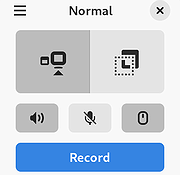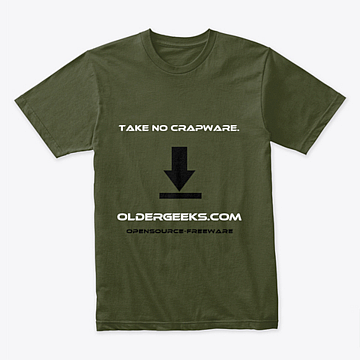 |
Kooha v2.2.4
Kooha v2.2.4
Elegantly record your screen in Linux.
Capture your screen in a intuitive and straightforward way without distractions.
Kooha is a simple screen recorder with a minimal interface. You can simply click the record button without having to configure a bunch of settings.
The main features of Kooha include the following:
🎙️ Record microphone, desktop audio, or both at the same time
📼 Support for WebM, MP4, GIF, and Matroska formats
🖥️ Select a monitor, a window, or a portion of the screen to record
🗔 Multiple sources selection
🛠️ Configurable saving location, pointer visibility, frame rate, and delay
🚀 Experimental hardware-accelerated encoding
😕 It Doesn't Work
There are many possibilities on why it may not be working. You may not have the runtime requirements mentioned below installed, or your distro doesn't support it. For troubleshooting purposes the screen cast compatibility page of xdg-desktop-portal-wlr wiki may be helpful in determining if your distro has support for it out of the box. If it does, but it still doesn't work, you can also check for the troubleshooting checklist.
Experimental Features
These features are disabled default due to stability issues and possible performance degradation. However, they can be enabled manually by running Kooha with KOOHA_EXPERIMENTAL env var set to 1. (e.g. KOOHA_EXPERIMENTAL=1 flatpak run io.github.seadve.Kooha).
Enable hardware accelerated encoding and other encoders
Together with KOOHA_EXPERIMENTAL env var, it is also needed to set GST_VAAPI_ALL_DRIVERS to 1 to enable the needed drivers.
Additionally, gstreamer-vaapi is required to be installed on your system. If Kooha is installed through Flatpak, it is as simple as running flatpak install org.freedesktop.Platform.GStreamer.gstreamer-vaapi to install the package.
Recording specific window
Due to flickering, this has been disabled by default, but can be enabled through KOOHA_EXPERIMENTAL env var.
Runtime Requirements
... |
 |
1,692 |
Mar 18, 2024
Dave Patrick Caberto  |
 |
TurboVNC v2.2.4 (MacOS)
TurboVNC v2.2.4 (MacOS)
TurboVNC is a derivative of VNC (Virtual Network Computing) that is tuned to provide peak performance for 3D and video workloads. TurboVNC was originally a fork of TightVNC 1.3.x, and on the surface, the X server and Windows viewer still behave similarly to their parents. However, the current version of TurboVNC contains a much more modern X server code base (based on X.org 7.7) and a variety of other features and fixes not present in TightVNC, including a high-performance Java viewer. In addition, TurboVNC compresses 3D and video workloads significantly better than the “tightest” compression mode in TightVNC 1.3.x while using only typically 15-20% of the CPU time of the latter. Using non-default settings, TurboVNC can also match the best compression ratios produced by TightVNC 1.3.x for 2D workloads. Furthermore, TurboVNC contains some unique features that are designed specifically for visualization applications.
All VNC implementations, including TurboVNC, use the RFB (remote framebuffer) protocol to send “framebuffer updates” from the VNC server to any connected "viewers." Each framebuffer update can contain multiple "rectangles" (regions that have changed since the last update.) As with TightVNC, TurboVNC analyzes each rectangle, splits it into multiple "subrectangles", and attempts to encode each subrectangle using the "subencoding type" that will provide the most efficient compression, given the number of unique colors in the subrectangle. The process by which TurboVNC does this is referred to as an "encoding method." A rectangle is first analyzed to determine if any significant portion of it is solid, and if so, that portion is encoded as a bounding box and a fill color ("Solid subencoding.") Of the remaining subrectangles, those with only two colors are encoded as a 1-bit-per-pixel bitmap with a 2-color palette ("Mono subencoding"), those with low numbers of unique colors are encoded as a color palette ... |
 |
4,138 |
Mar 17, 2020
turbovnc.org  |
 |
TurboVNC v2.2.4 (Win32)
TurboVNC v2.2.4 (Win32)
TurboVNC is a derivative of VNC (Virtual Network Computing) that is tuned to provide peak performance for 3D and video workloads. TurboVNC was originally a fork of TightVNC 1.3.x, and on the surface, the X server and Windows viewer still behave similarly to their parents. However, the current version of TurboVNC contains a much more modern X server code base (based on X.org 7.7) and a variety of other features and fixes not present in TightVNC, including a high-performance Java viewer. In addition, TurboVNC compresses 3D and video workloads significantly better than the “tightest” compression mode in TightVNC 1.3.x while using only typically 15-20% of the CPU time of the latter. Using non-default settings, TurboVNC can also match the best compression ratios produced by TightVNC 1.3.x for 2D workloads. Furthermore, TurboVNC contains some unique features that are designed specifically for visualization applications.
All VNC implementations, including TurboVNC, use the RFB (remote framebuffer) protocol to send “framebuffer updates” from the VNC server to any connected "viewers." Each framebuffer update can contain multiple "rectangles" (regions that have changed since the last update.) As with TightVNC, TurboVNC analyzes each rectangle, splits it into multiple "subrectangles", and attempts to encode each subrectangle using the "subencoding type" that will provide the most efficient compression, given the number of unique colors in the subrectangle. The process by which TurboVNC does this is referred to as an "encoding method." A rectangle is first analyzed to determine if any significant portion of it is solid, and if so, that portion is encoded as a bounding box and a fill color ("Solid subencoding.") Of the remaining subrectangles, those with only two colors are encoded as a 1-bit-per-pixel bitmap with a 2-color palette ("Mono subencoding"), those with low numbers of unique colors are encoded as a color palette ... |
 |
4,408 |
Mar 17, 2020
turbovnc.org  |
 |
TurboVNC v2.2.4 (Win64)
TurboVNC v2.2.4 (Win64)
TurboVNC is a derivative of VNC (Virtual Network Computing) that is tuned to provide peak performance for 3D and video workloads. TurboVNC was originally a fork of TightVNC 1.3.x, and on the surface, the X server and Windows viewer still behave similarly to their parents. However, the current version of TurboVNC contains a much more modern X server code base (based on X.org 7.7) and a variety of other features and fixes not present in TightVNC, including a high-performance Java viewer. In addition, TurboVNC compresses 3D and video workloads significantly better than the “tightest” compression mode in TightVNC 1.3.x while using only typically 15-20% of the CPU time of the latter. Using non-default settings, TurboVNC can also match the best compression ratios produced by TightVNC 1.3.x for 2D workloads. Furthermore, TurboVNC contains some unique features that are designed specifically for visualization applications.
All VNC implementations, including TurboVNC, use the RFB (remote framebuffer) protocol to send “framebuffer updates” from the VNC server to any connected "viewers." Each framebuffer update can contain multiple "rectangles" (regions that have changed since the last update.) As with TightVNC, TurboVNC analyzes each rectangle, splits it into multiple "subrectangles", and attempts to encode each subrectangle using the "subencoding type" that will provide the most efficient compression, given the number of unique colors in the subrectangle. The process by which TurboVNC does this is referred to as an "encoding method." A rectangle is first analyzed to determine if any significant portion of it is solid, and if so, that portion is encoded as a bounding box and a fill color ("Solid subencoding.") Of the remaining subrectangles, those with only two colors are encoded as a 1-bit-per-pixel bitmap with a 2-color palette ("Mono subencoding"), those with low numbers of unique colors are encoded as a color palette ... |
 |
4,245 |
Mar 17, 2020
turbovnc.org  |














